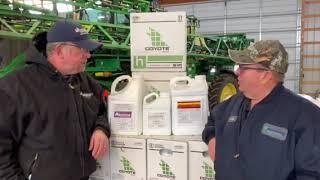COYOTE™: A SMART CHOICE FOR FLEXIBLE WEED CONTROL
Jan 11, 2021

Coyote™ is a non-restricted herbicide for field, seed, and sweet corn, yellow popcorn, and grain sorghum (milo); it controls more than 50 broadleaf and grass weeds. Craig Peterson, Federated agronomist at the Ogilvie location, highlighted its flexibility as a pre- or post-emerge herbicide and its strong potential for residual weed control. See video below.
Coyote is a mixture of S-Metolachlor (Dual II Magnum®) and Mestrione (Callisto®) with a recommended pre-emerge use rate of 1.6 to 2.4 qt./ac. (2 qt./ac. as the maximum rate for soils with 3% or less organic matter). Peterson said, “Using the highest [appropriate] rate on your field will give you longer lasting residual.” (2 qt. Coyote = 1.75 pt. Dual and 5 ¼ oz. Callisto)
For post emerge applications, tank mix Coyote with glyphosate (only if you are using a glyphosate-tolerant system) because Coyote does not contain grass burndown ingredients. “A quarter to half pound of atrazine [per acre] will also enhance control,” said Peterson.
“Coyote is very similar to Halex GT® but doesn’t have the glyphosate premixed,” said Peterson. Coyote does have a safener for pre-emerge applications, which makes it an excellent choice for conventional corn,” he added. Coyote requires a nonionic surfactant (such as Tradition 93®) and water conditioner (AMS).
“Coyote gives you some nice flexibility with getting chemistry down as soon as possible, but if weather delays your application, you still have the post-emerge option,” said Peterson. Talk to your Federated Agronomist to determine if Coyote is the right choice for weed control in your corn fields in 2021.